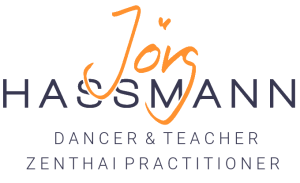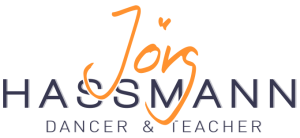The ‘unwinding small dance’ – A daily practice for contacters?
I’d wish for a daily practice for me as a Contact Improviser. But I had to realized that CI as a daily practice doesn’t really work for me. I envy people who practice Yoga or martial arts. There is so much deepening possible by just repeating the basics over and over again. There is enough material that needs solo practice.
Contact Improvisation needs solo practice, too. But it is very open what that could be and it makes sense to feed CI from different angles. There is no clear solo practice for CI. The actual practice of this dance happens with a partner and a group. That involves all of a sudden a huge complexity on very different levels. There is too much communication and negotiation necessary. What do I need, what does my partner do or need? Sensing my own body, sensing the connection through touch. Reading my partner. Leading and following. Finding my interest, getting lost. All that is only a preparation for the journey through a jam situation,which is an even more complex thing. Too many options. It is very hard to find a clear and simple focus for a simple practice.
The unwinding small dance
In the last year I found myself developing a physical practice that I use on a regular basis for myself. It suits my limitations of fatherhood, where I don’t have so much time on my own in a studio or even at home to connect to my body. It is a practice that I can do almost any moment, while my little boy is playing happily alone but still needing my presence around, or in the gaps that I try to keep when I do my office work. R to prepare for a jam, of course…
I call it ‘the unwinding small dance’.
From the small dance to the ‘unwinding small dance’
My ‘unwinding small dance’ is based on sensing the physically available options of my body and includes inner and outer awareness, leading and following, the play with dynamics, the use of eyes, making choices, having little plans and letting them go.
I found it by accident, practicing the small dance, which is basically a physical meditation in standing from the early days of CI. Standing with the least necessary muscular effort, allowing the bones to carry as much of my weight as possible. Standing as a dynamic process with the idea of open joints and a constant balancing. Listening to the moments of loosing balance and listening to the body reflexes to catch balance again. Maximum openness and availability in all joints, maximum readiness in our reflex body. Super simple – just standing – and highly complex at the same time. A while ago I wrote a text about it (you find it in my blog, too).
Soon I realized that I invite more openness and balancing movements just by directing my inner focus to specific areas of my body. Then I sense a desire in my body to move even more, to go beyond only doing the least necessary to not fall. As if all joints have little desires to be moved. But not just ‘being moved however’. I feel like asking a joint ‘So, where do you want to move right now?’ and I get a surprisingly clear answer. I can follow the movement desires of a joint. In a way the joint is the leader and I am the follower. It is a very sweet an subtile conversation, especially in the beginning. Sometimes a joint doesn’t know where it wants to move. Then I can ask more directive. I can offer a movement and listen to the joints answer. It is surprisingly clear (at least in my body) where a joint says ‘ Oh, yes, that’s a nice direction!’ or when the answer is ‘please, no, try something else!’ I practice to listen to the ‘yes’ and the ‘no’ of my body, switching from only listening and following to suggesting directions and letting go of these little plans if they don’t fit the needs of that specific body part.
From sensing and listening to more activity
In a small dance situation I find it the easiest to focus on a certain part of my spine, like the lower thoracic spine or the neck including the connection to the head. To get my whole body involved it helps me to focus on one arm, starting with all the joints in the hand and fingers. Rather soonish the wrist can become engaged and then elbow. To lift the arm it might need a stronger invitation from my mind, but usually my body is very pleased with this proposal. It is a crucial moment: lifting an arm needs a different muscular activity than the pure balancing in standing. But the principal of proposing directions and accepting the ‘yes’ and the ‘no’ stays the same. Once the communication between my mind and a specific area of my body is working I can step back a little more with my mind. The movement desires of this body part become more obvious and I try not to stand in its way. It feels like the motor is ‘on’ now. My body actually wants to move. That is often the moment when I like to include little plans or desires of my mind. Are there moments when my head can move more into the backspace? How much extension is possible in my arm without stressing the communication? I find it remarkable how much extension and soft stretches my body actually wants to go through. I often imagine that my body is lazy, happy to stay with the least necessary effort, floating along. But my body loves researching the edges of the deep comfort zone. Amazing what is possible with a sensation of openness. The floatiness stays even in situations of reach and arch.
Getting the whole body involved
The starting point is often easier with closed eyes. Physical sensations are easier to perceive. Can I keep the sense of connectedness and communication with open eyes? Playing with opening and closing eyes or blinking is helpful in this transition. I can even explore the rhythm of my eyes opening and closing. I can play with the idea of my eyes being another limb like an arms or a leg. Eyes can focus, like a hand can touch or grab. And eyes can move softly open through space or draw clear lines on the wall, like a hand when it decides to become an extension of the arm.
My aim is to eventually ask all my joints at the same time where they want to move in each single moment. That is not possible of course, but it is a very interesting direction. Which body parts get stuck in a locked or collapsed position? Is that really the desire of this body part? The amount of inner spirals that happens without being just manic or chaotic is fantastic. I find a sense, that everything is connected. To reach that state the center needs to find an active mode. It is easily connected to the question:
How do I get my legs involved? Shifting weight from one leg to the other and testing when a leg without weight likes to turn in or out.
Including lower levels
Can I keep a taste of this lightness, openness, willingness for whole body connections and movements when I include lower levels. Once I leave standing and walking as a base, gravity starts to play a very different and more challenging role. In standing the bones know pretty well how to organize to rise against gravity in order to free the other limbs. In the transitioning level to the floor often three or even four extremities are needed to support our weight. Which limbs are still free, like head, tale and eyes? How much movement is still available in extremities that carry weight?
On the floor level. When does it make sense to lower the muscle tone in the limbs to benefit from being carried by the floor. Are my limbs they still willing to fold and open, to spiral? When do they like to explore the space above?
Timing and body tone
Without loosing the basic sense of connectedness and ease I like to play with acceleration and slowing down. When and how quickly can I accelerate? When does my body say ‘Thank you!’ for an almost-pause connecting back to the subtlety of directions in open joints? Or more generally: Which movements and kinds of activity are possible while keeping this established sense of connectedness and in which moments do I loose it? And: What does my body need to find it again?
Challenges
The base line is to follow the ‘yes’ and to accept the ‘no’s’. My body is often happy to be challenged (but not to be pushed beyond the limits!). How far can I go? When does a ‘yes’ loose its clarity and turns into an ‘ok’ or into a ‘not really, but…’. When can I adjust my challenge and when does it make more sense to let it go? When is it the best to switch back to pure following?
Dissociation in mind and body?
The intelligence of body and mind are connected but also very different. ‘All is one’ might be an aim. It can happen in moments of flow or intuitive states. But the ability to make and enjoy choices is a big advantage and gift of the mind. The mind is slow – and detailed only with a rather narrow focus. The mind can help to uncover unconscious and unhealthy patterns, stopping negative spirals, giving rough directions.
The body is this miraculous thing, that – once it is ‘on’ and in a state of trust and connectedness – is able to do amazing things without hesitation, knowing exactly what is possible and what isn’t, detailed knowledge in the entire body is available all at the same time. Reflexes based on trust ….
The links between the unwinding small dance and CI
In the touch – Finding the directions in the tissue under the touch. Where is the ‘yes’ and no of my partners structure/ body? When do I purely follow, when do I suggest a direction? Can I stay open and let go of my proposal instantly if I feel my partner’s body has no ‘yes’ for it?
How much space for the quality of the unwinding small dance can I give my CI partner. How much of it can stay alive when more shared weight gets involved?
In bodywork warm ups – Bodywork into movement and dance uses in my practice the same approach than what I do with my own body in the unwinding small dance. Just that my body-mind system connects to certain parts of my partners body: making suggestions, listening to its ‘yes’ and ‘no’ and eventually giving space for my partner to find her own way to move while I follow and support the directions that I find. Eventually I can mix: following, suggesting and challenging my partner, always accepting the no’s.


